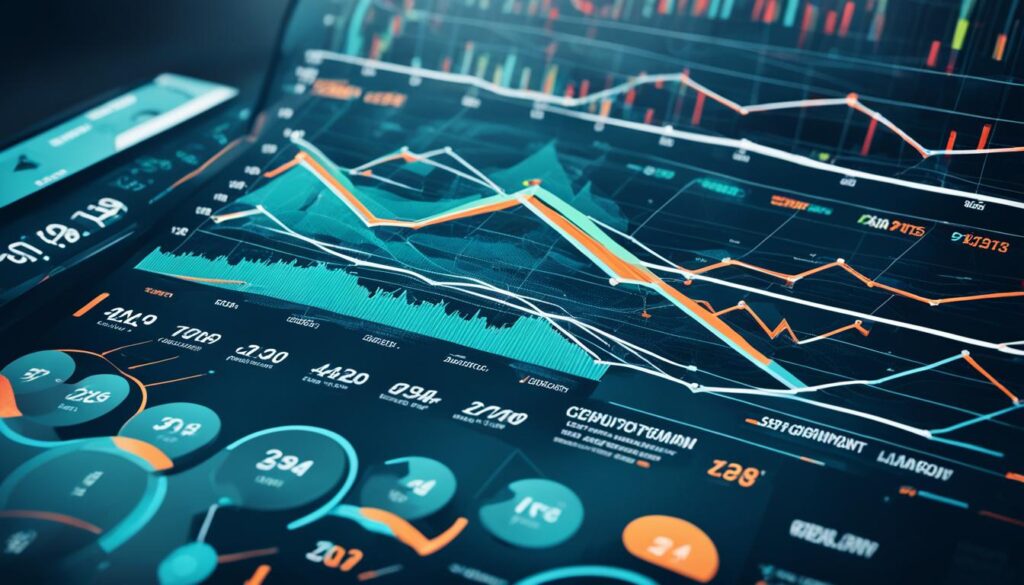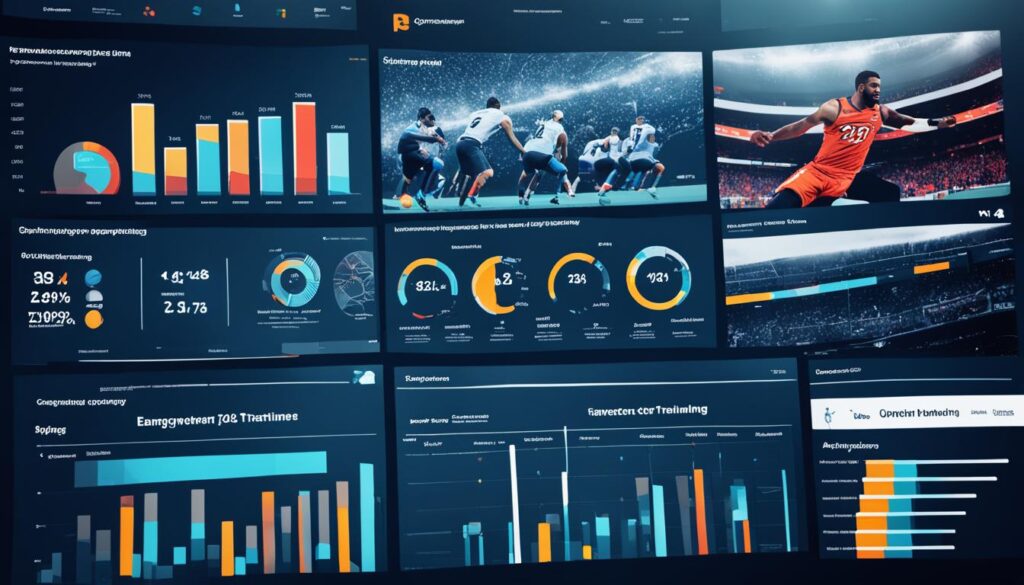The integration of data analytics in sports has revolutionized the way games are played and managed, offering unprecedented insights and opportunities for improvement. From optimizing performance on the field to engaging with fans off the field, data analytics has become an essential tool for success in the sports industry.
Sports organizations and teams are harnessing the power of sports performance analytics and sports data analysis to gain a competitive edge. By collecting and analyzing vast amounts of data, they can make data-driven decisions that maximize player performance, optimize game strategies, and drive organizational growth.
The significance of sports industry data insights cannot be overstated. With the market projected to exceed $4 billion by 2023, it is clear that data analytics has become an integral part of sports management and strategy. By leveraging these insights, teams can enhance player performance, improve fan engagement, and revolutionize organizational strategies.
Key Takeaways:
- Data analytics in sports provides game-changing insights for performance optimization and fan engagement.
- By utilizing sports performance analytics and data analysis, teams can make data-driven decisions for success.
- The sports industry data insights market is projected to exceed $4 billion by 2023.
- Data analytics revolutionizes player performance, fan engagement, and organizational strategies.
- Embracing data-driven decision-making is crucial for the success of sports organizations in the modern era.
The Role of Data Analytics in Sports Performance
Data analytics has become a game-changer in enhancing sports performance. Through the use of predictive analytics, teams are able to gain valuable insights into player performance and make data-driven decisions that optimize their strategies. This shift towards data-driven decision-making has revolutionized sports strategy, allowing teams to gain a competitive edge in their performance.
One key aspect of utilizing data analytics in sports is the analysis of sports technology trends. By staying ahead of the curve and embracing innovative techniques, teams can leverage technology to improve their performance on the field. Whether it’s using wearable devices to track player movements or adopting new training methodologies based on performance data, sports technology trends play a vital role in enhancing overall team performance.
Furthermore, data-driven decision-making has become an essential aspect of sports strategy. With the wealth of data available, teams can make informed decisions about game tactics, player selection, and team formations. By analyzing past performance data, teams can identify patterns, strengths, and weaknesses, allowing them to optimize their tactics for better results on the field.
“Data-driven decision-making has become a crucial aspect of sports strategy, helping teams optimize their tactics and gain a competitive edge.”
Whether it’s analyzing player statistics, monitoring player fitness levels, or measuring the effectiveness of training regimens, data analytics provides teams with a comprehensive understanding of their overall performance. This data-driven approach not only improves individual player performance but also enhances team dynamics and coordination, ultimately leading to better outcomes on the field.
The Impact of Predictive Analytics in Sports
Predictive analytics has emerged as a key tool in sports performance analysis. By analyzing historical performance data, player statistics, and other relevant variables, predictive analytics offers insights into future outcomes. This enables teams to make better decisions about player selection, game strategy, and overall team performance. The ability to predict potential player injuries or identify breakout players is invaluable for teams looking to gain a competitive edge.
The use of predictive analytics in sports has several applications. For example, in basketball, teams can analyze shooting strategies and identify the most efficient ways to score points. In soccer, predictive analytics can help teams understand player positioning and optimize their passing strategies. By utilizing predictive models, teams can make data-driven decisions that maximize their chances of success.
Sports Technology Trends Driving Performance
The world of sports is constantly evolving, driven by advancements in technology. Understanding and adapting to these sports technology trends is crucial for teams to stay competitive. From analyzing player biometrics to utilizing virtual reality training programs, teams are harnessing the power of technology to unlock greater potential.
This table highlights some of the key sports technology trends that are transforming sports performance:
| Trend | Description |
|---|---|
| Wearable Devices | Track player performance, biometrics, and even provide real-time feedback during training and games. |
| Virtual Reality | Simulate game scenarios and provide immersive training experiences for players to enhance decision-making skills and reaction times. |
| Video Analysis | Analyze game footage to identify player and team performance patterns, strengths, and weaknesses. |
| Data Visualization | Present complex data in clear and meaningful ways, enabling coaches and athletes to make informed decisions. |
These sports technology trends offer teams new opportunities to gain a competitive edge and unlock untapped potential. By embracing these technologies, teams can enhance their training methods, improve player performance, and optimize game strategies.

Enhancing Fan Engagement through Sports Data Analysis
Sports organizations are utilizing data analytics to revolutionize fan engagement and create personalized experiences. By leveraging sports data visualization techniques, such as augmented reality, teams can provide immersive and captivating experiences for fans, increasing their overall satisfaction and connection to the game.
One innovative sports analytics technique that drives fan engagement is the tracking of fan behaviors and preferences. Through data analysis, organizations gain valuable insights into fan interests, enabling them to develop targeted marketing strategies. Understanding fan preferences allows organizations to tailor their content, promotions, and merchandise offerings to better align with fan expectations and desires.
Industry data insights play a crucial role in enhancing fan engagement. By analyzing market trends and fan behaviors, sports organizations can gain a comprehensive understanding of their target audience and the larger sports industry landscape. These insights enable organizations to craft strategies that resonate with existing fans while also attracting new ones.
For example, a sports organization could utilize data to identify a growing trend of fans showing interest in sustainable initiatives. Armed with this information, they could implement eco-friendly practices within their venues and promote these efforts to connect with environmentally conscious fans, enhancing both fan engagement and loyalty.
Augmented Reality: A Paradigm Shift in Fan Engagement
One of the most exciting sports data visualization techniques in recent years is augmented reality (AR). AR technology allows fans to experience games like never before, providing an immersive and interactive experience that transcends traditional viewing methods.
With AR, fans can view player statistics in real-time, access exclusive behind-the-scenes content, and even participate in virtual simulations of game scenarios. This cutting-edge technology enhances fan engagement by bringing them closer to the action and making them an active part of the game experience.

Table: Comparison of Traditional Fan Engagement vs. Enhanced Fan Engagement through Sports Data Analysis
| Traditional Fan Engagement | Enhanced Fan Engagement through Sports Data Analysis |
|---|---|
| Passive viewing experience | Interactive and immersive experience |
| Limited access to player and team insights | Real-time access to rich player and team data |
| Generic content and promotions | Personalized content and targeted promotions |
| Minimal fan involvement | Active participation in game simulations and decisions |
The use of sports data analysis has transformed fan engagement, creating a dynamic and interactive experience for sports enthusiasts. As technology continues to advance, we can expect even more innovative techniques to further enhance fan engagement and solidify the bond between fans and their favorite teams.
The Impact of Data Analytics on Organizational Strategies
Data analytics is not limited to game-day tactics; it also plays a significant role in shaping organizational strategies within the sports industry. Sports organizations are harnessing the power of analytics to make informed decisions and drive success in multiple areas.
One area where data analytics has had a profound impact is in injury prevention and player health. By analyzing data on player performance, workload, and physical attributes, teams can identify potential risks and develop targeted strategies to minimize injuries. This approach not only improves player well-being but also reduces long-term healthcare costs and enhances player career longevity.
Analytics also revolutionize marketing and fan engagement strategies. By leveraging sports industry data insights, organizations can understand fan behaviors and preferences on a deeper level. This knowledge allows for personalized marketing campaigns and enhanced fan experiences, leading to increased ticket sales and merchandise revenue.
Moreover, data-driven decision making has become essential for sports organizations to maintain a competitive edge in a rapidly evolving industry. By basing strategic decisions on insights derived from comprehensive data analysis, organizations can optimize their performance on and off the field.
Data analytics is the driving force behind evidence-based decision making in the sports industry. It empowers organizations to make smarter choices, backed by quantitative insights, and enables them to stay ahead in a fiercely competitive landscape.
Implementing data-driven strategies can transform the efficiency and effectiveness of sports organizations in various aspects, from talent acquisition and player development to marketing and revenue generation. By leveraging sports industry data insights and embracing sports data-driven decision making, organizations can unlock the full potential of their resources, optimize performance, and drive sustainable success.
The Paradigm Shift of Data Analytics in Sports
The integration of data analytics in sports has led to a significant paradigm shift within the industry. The success stories across various sports clearly demonstrate the transformative power of data-driven decision-making. With the increasing interest in sports careers and the growing need for real-time tracking and monitoring of player data, the sports analytics market is projected to reach an estimated value of $4.6 billion by 2025. Data analytics is no longer just a passing trend; it has become central to the success and innovation in sports. Organizations that fail to embrace the power of data risk falling behind in this data-centric era.

In today’s sports landscape, teams and organizations are leveraging data analytics to gain a competitive edge. Analyzing trends and patterns in sports technology allows teams to stay ahead of the curve and adopt innovative techniques to improve performance.
The Impact of Data Analytics in Sports
Data analytics in sports has revolutionized the way teams strategize and make decisions. By harnessing the power of sports data visualization, organizations can better understand and communicate complex insights to players, coaches, and fans. Through innovative visualizations, such as heat maps, motion tracking, and interactive dashboards, teams can analyze performance metrics, player movements, and strategies in a more intuitive and accessible manner.
“The integration of data analytics has completely transformed the game. We now have the ability to analyze player performance, identify trends, and make data-driven decisions that can give us a competitive advantage.” – Coach Sarah Johnson
Additionally, data analytics has enabled sports organizations to enhance fan engagement and create personalized experiences. Utilizing fan data and preferences, teams can tailor marketing strategies, targeted promotions, and immersive experiences that resonate with their fans on a deeper level. This not only increases fan loyalty but also expands global fanbases.
Data-Driven Success Stories
The impact of data analytics in sports can be seen across various sports disciplines. For example, in basketball, teams are utilizing advanced analytics to optimize shooting strategies, identify high-percentage shots, and make better decisions on the court. In football, analytics are revolutionizing player recruitment and talent evaluation, enabling teams to identify undervalued players and make more informed financial investments.
Table: Data Analytics Success Stories
| Sport | Success Story |
|---|---|
| Basketball | Analyzing shooting patterns to improve shot selection and accuracy. |
| Football | Utilizing player tracking data to optimize player positioning and improve defensive strategies. |
| Baseball | Applying advanced metrics to evaluate player performance and value. |
As data analytics continues to evolve and shape the sports industry, organizations that embrace its power will be at the forefront of innovation and success. The future of sports is driven by data, and those who adapt to this new paradigm will have a competitive advantage in optimizing performance, engaging fans, and making strategic decisions.
The Role of Machine Learning in Sports Analytics
Machine learning has revolutionized sports analytics, providing teams and athletes with a competitive advantage in the world of sports performance analytics and sports data analysis. By utilizing sophisticated algorithms and predictive modeling, machine learning enables teams to analyze vast amounts of data and extract meaningful insights that can drive decision-making and improve overall performance.
With machine learning, sports organizations can delve into performance metrics, game strategies, and team dynamics to uncover patterns and trends that may not be readily apparent to the naked eye. These algorithms have the ability to recognize subtle correlations and dependencies within the data, allowing for more accurate predictions and informed decision-making by coaches and analysts.
One of the key benefits of machine learning in sports analytics is its ability to provide actionable insights. By analyzing historical data and real-time information, machine learning algorithms can offer teams valuable recommendations for optimizing performance, whether it’s adjusting training regimens, refining game strategies, or identifying potential areas of improvement.
“Machine learning algorithms have the potential to transform the way sports teams strategize and make decisions. By leveraging these advanced analytics techniques, teams can gain a deeper understanding of their own performance and the dynamics of their opponents, leading to a significant competitive advantage.”
Furthermore, the popularity of machine learning in sports analytics is driven by its ability to aid in sports data-driven decision making. Teams can harness the power of machine learning to make informed decisions based on objective data and statistical analysis, rather than relying solely on intuition or anecdotal evidence. This data-driven approach can minimize bias and improve the overall quality of decision-making processes.
However, implementing machine learning in sports analytics is not without its challenges. The collection and cleaning of data pose significant hurdles, as ensuring data accuracy and completeness is crucial for obtaining reliable results. Additionally, the integration of machine learning algorithms into existing sports technology systems may require substantial resources and expertise.
Despite these challenges, the growing adoption of machine learning in sports analytics highlights its potential to shape the future of sports performance analysis. With ongoing advancements in technology and an ever-increasing volume of data, machine learning will continue to play a pivotal role in sports analytics, enabling teams to unlock new insights and achieve peak performance.
| Benefits of Machine Learning in Sports Analytics |
|---|
| 1. Improved Performance Metrics Analysis |
| 2. Enhanced Game Strategies |
| 3. Accurate Predictive Modeling |
| 4. Objective Data-Driven Decision Making |
By leveraging the power of machine learning in sports analytics, sports organizations can gain a competitive edge in today’s data-driven sporting landscape. From optimizing performance metrics to making informed decisions, the integration of machine learning continues to drive innovation and propel sports analytics to new heights.

Conclusion
Data analytics has revolutionized the sports industry, transforming the game and rewriting its rules. The integration of data analytics in sports has become essential for optimizing game performance and enhancing fan engagement. Sports organizations are leveraging the power of data to gain valuable insights, make data-driven decisions, and stay ahead of the competition.
In recent years, the introduction of machine learning in sports analytics has taken the industry to new heights. By utilizing machine learning algorithms, teams and athletes have gained a competitive advantage by analyzing performance metrics, game strategies, and team dynamics. This integration of technology has provided valuable insights and has become an indispensable tool in the sports industry.
As the sports industry evolves, the importance of data analytics and machine learning in sports will continue to grow. Embracing data-driven decision-making and adopting innovative analytics techniques is crucial for the success of sports organizations in the modern era. By harnessing the power of data, teams can optimize player performance, improve injury prevention measures, and drive fan engagement to new heights.
With data analytics at the core of sports strategy, organizations can make informed decisions and stay ahead of the ever-changing dynamics of the industry. The future of sports lies in the hands of data-driven insights and technological advancements, and it is imperative for sports organizations to adapt and embrace this transformation to secure their position in the highly competitive sports landscape.
FAQ
How has data analytics transformed the sports industry?
Data analytics has revolutionized the sports industry by optimizing game performance, enhancing fan engagement, and providing valuable insights for sports organizations.
What is the role of data analytics in sports performance?
Data analytics plays a critical role in sports performance by leveraging predictive analytics, analyzing sports technology trends, and enabling data-driven decision-making.
How does data analytics enhance fan engagement in sports?
Data analytics enhances fan engagement by utilizing sports data visualization techniques, tracking fan behaviors, and tailoring marketing strategies to increase fan loyalty.
How does data analytics impact organizational strategies in sports?
Data analytics impacts organizational strategies in sports by improving injury prevention, enhancing player health, and revolutionizing marketing and fan engagement strategies.
What is the significance of data analytics in the sports industry?
Data analytics represents a paradigm shift in the sports industry, aiding in game performance optimization, fan engagement, and innovation in sports.
What is the role of machine learning in sports analytics?
Machine learning revolutionizes sports analytics by providing actionable insights, analyzing performance metrics, and aiding decision-making by coaches and analysts.








